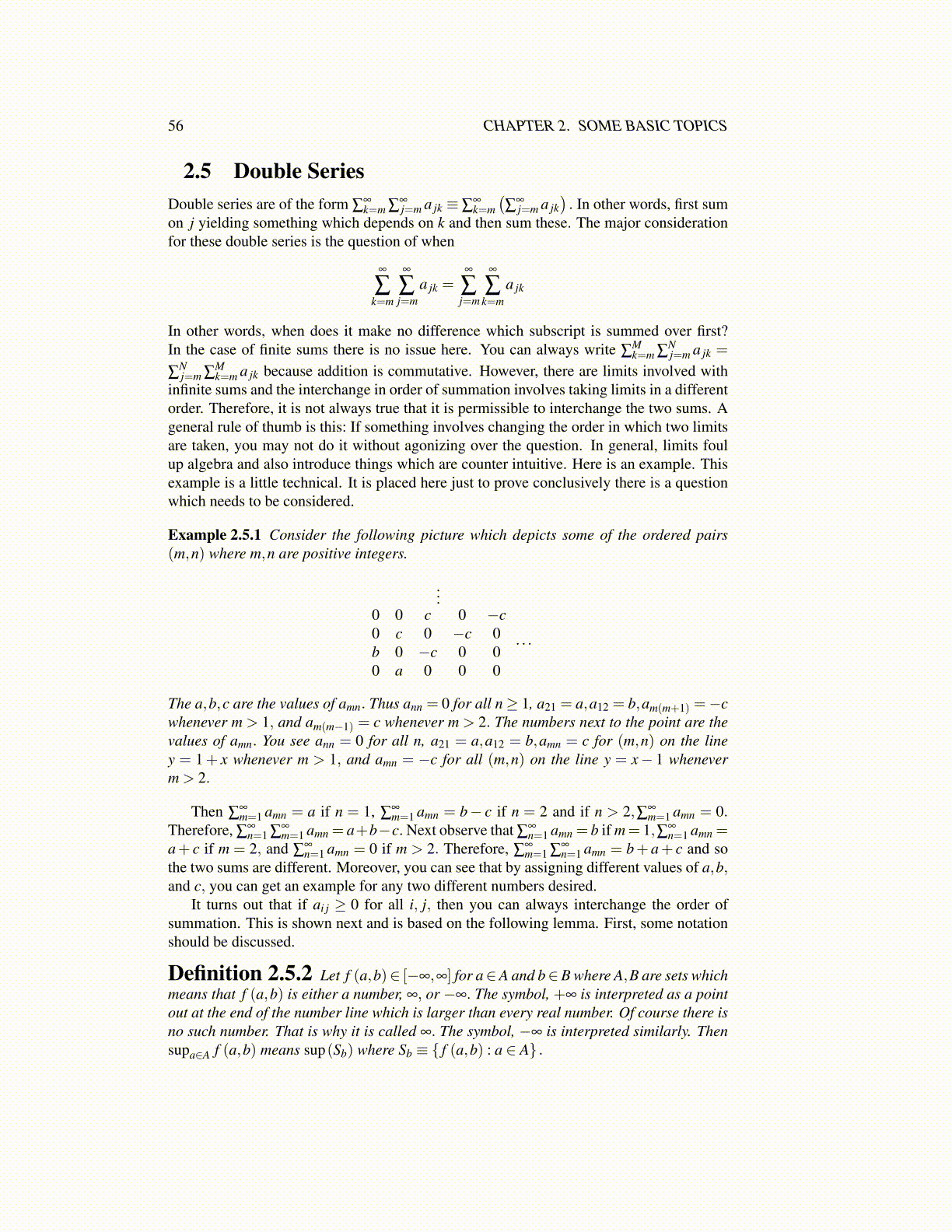
56 CHAPTER 2. SOME BASIC TOPICS
2.5 Double SeriesDouble series are of the form ∑
∞k=m ∑
∞j=m a jk ≡∑
∞k=m
(∑
∞j=m a jk
). In other words, first sum
on j yielding something which depends on k and then sum these. The major considerationfor these double series is the question of when
∞
∑k=m
∞
∑j=m
a jk =∞
∑j=m
∞
∑k=m
a jk
In other words, when does it make no difference which subscript is summed over first?In the case of finite sums there is no issue here. You can always write ∑
Mk=m ∑
Nj=m a jk =
∑Nj=m ∑
Mk=m a jk because addition is commutative. However, there are limits involved with
infinite sums and the interchange in order of summation involves taking limits in a differentorder. Therefore, it is not always true that it is permissible to interchange the two sums. Ageneral rule of thumb is this: If something involves changing the order in which two limitsare taken, you may not do it without agonizing over the question. In general, limits foulup algebra and also introduce things which are counter intuitive. Here is an example. Thisexample is a little technical. It is placed here just to prove conclusively there is a questionwhich needs to be considered.
Example 2.5.1 Consider the following picture which depicts some of the ordered pairs(m,n) where m,n are positive integers.
...0 0 c 0 −c0 c 0 −c 0b 0 −c 0 00 a 0 0 0
· · ·
The a,b,c are the values of amn. Thus ann = 0 for all n≥ 1, a21 = a,a12 = b,am(m+1) =−cwhenever m > 1, and am(m−1) = c whenever m > 2. The numbers next to the point are thevalues of amn. You see ann = 0 for all n, a21 = a,a12 = b,amn = c for (m,n) on the liney = 1+ x whenever m > 1, and amn = −c for all (m,n) on the line y = x− 1 wheneverm > 2.
Then ∑∞m=1 amn = a if n = 1, ∑
∞m=1 amn = b− c if n = 2 and if n > 2,∑∞
m=1 amn = 0.Therefore, ∑
∞n=1 ∑
∞m=1 amn = a+b−c. Next observe that ∑
∞n=1 amn = b if m= 1,∑∞
n=1 amn =a+ c if m = 2, and ∑
∞n=1 amn = 0 if m > 2. Therefore, ∑
∞m=1 ∑
∞n=1 amn = b+ a+ c and so
the two sums are different. Moreover, you can see that by assigning different values of a,b,and c, you can get an example for any two different numbers desired.
It turns out that if ai j ≥ 0 for all i, j, then you can always interchange the order ofsummation. This is shown next and is based on the following lemma. First, some notationshould be discussed.
Definition 2.5.2 Let f (a,b)∈ [−∞,∞] for a∈A and b∈B where A,B are sets whichmeans that f (a,b) is either a number, ∞, or −∞. The symbol, +∞ is interpreted as a pointout at the end of the number line which is larger than every real number. Of course there isno such number. That is why it is called ∞. The symbol, −∞ is interpreted similarly. Thensupa∈A f (a,b) means sup(Sb) where Sb ≡ { f (a,b) : a ∈ A} .